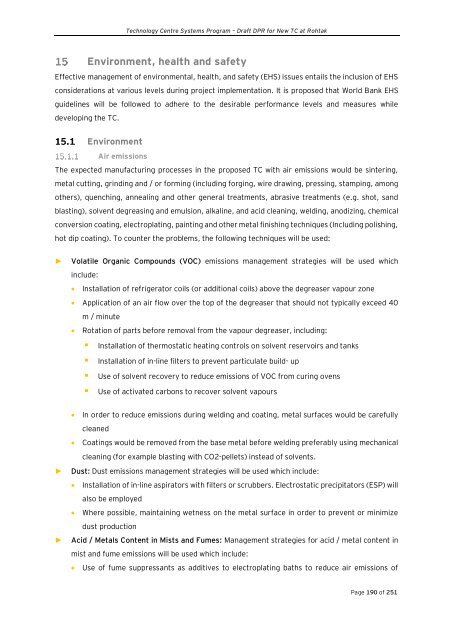Draft Detailed Project Report
Rohtak
Rohtak
You also want an ePaper? Increase the reach of your titles
YUMPU automatically turns print PDFs into web optimized ePapers that Google loves.
Technology Centre Systems Program – <strong>Draft</strong> DPR for New TC at Rohtak<br />
Environment, health and safety<br />
Effective management of environmental, health, and safety (EHS) issues entails the inclusion of EHS<br />
considerations at various levels during project implementation. It is proposed that World Bank EHS<br />
guidelines will be followed to adhere to the desirable performance levels and measures while<br />
developing the TC.<br />
Environment<br />
Air emissions<br />
The expected manufacturing processes in the proposed TC with air emissions would be sintering,<br />
metal cutting, grinding and / or forming (including forging, wire drawing, pressing, stamping, among<br />
others), quenching, annealing and other general treatments, abrasive treatments (e.g. shot, sand<br />
blasting), solvent degreasing and emulsion, alkaline, and acid cleaning, welding, anodizing, chemical<br />
conversion coating, electroplating, painting and other metal finishing techniques (Including polishing,<br />
hot dip coating). To counter the problems, the following techniques will be used:<br />
►<br />
Volatile Organic Compounds (VOC) emissions management strategies will be used which<br />
include:<br />
Installation of refrigerator coils (or additional coils) above the degreaser vapour zone<br />
Application of an air flow over the top of the degreaser that should not typically exceed 40<br />
m / minute<br />
Rotation of parts before removal from the vapour degreaser, including:<br />
• Installation of thermostatic heating controls on solvent reservoirs and tanks<br />
• Installation of in-line filters to prevent particulate build- up<br />
• Use of solvent recovery to reduce emissions of VOC from curing ovens<br />
• Use of activated carbons to recover solvent vapours<br />
►<br />
►<br />
In order to reduce emissions during welding and coating, metal surfaces would be carefully<br />
cleaned<br />
Coatings would be removed from the base metal before welding preferably using mechanical<br />
cleaning (for example blasting with CO2-pellets) instead of solvents. <br />
Dust: Dust emissions management strategies will be used which include:<br />
Installation of in-line aspirators with filters or scrubbers. Electrostatic precipitators (ESP) will<br />
also be employed<br />
Where possible, maintaining wetness on the metal surface in order to prevent or minimize<br />
dust production<br />
Acid / Metals Content in Mists and Fumes: Management strategies for acid / metal content in<br />
mist and fume emissions will be used which include:<br />
Use of fume suppressants as additives to electroplating baths to reduce air emissions of<br />
Page 190 of 251


